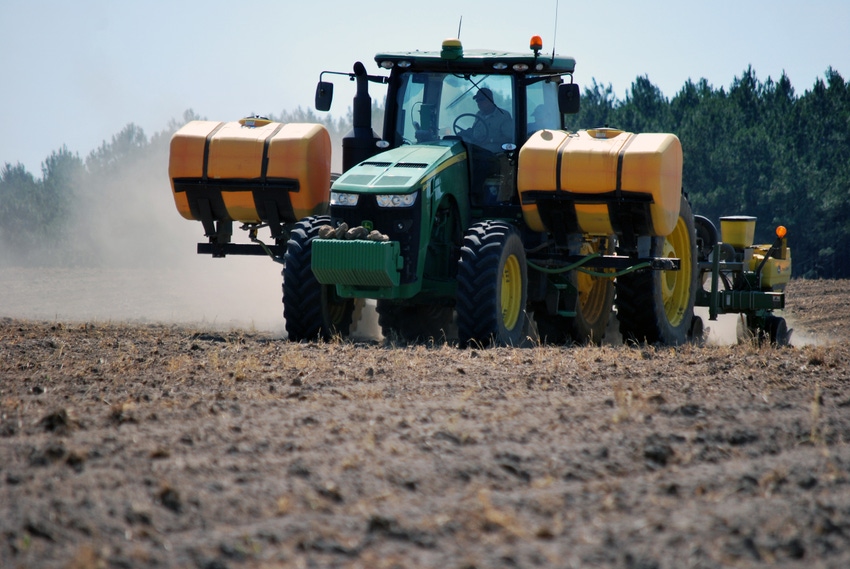
Southeast farmers plan to plant more acres of peanuts, a few more of soybeans, less of corn, but a lot more of cotton this year, according to the always-anticipated annual USDA Prospective Planting Report, which hit the streets March 31.
The Prospective Plantings report supports the cost and returns outlook for Southeast growers as they examine their crop mix. Cotton, peanut and soybean prices are higher relative to this time last year and thus we expect a shift toward these crops, especially cotton. Risk management strategies play into the decision with low margins projected. Growers are looking not only at their chances for profitability by crop but also opportunities to protect revenue,” said Nathan Smith, Clemson University Extension economist.
According to the report, total planted cotton acres for 2017 will be 12.2 million acres, 21 percent more than last year. Upland cotton will account for 12 million of those acres, a 2.1 million acre jump over last year’s upland acreage. The only Southeast state that plans to plant less cotton this year is Florida, which might go 85,000 acres, or the same acreage planted in 2015.
A positive prolonged shift in cotton prices (Dec17 cotton stayed steady at about 73 cents on the heels of the report) seems to have gotten the attention of farmers in other states.
Texas still plans to lead the nation in upland cotton with 6.9 million planted acres, 22 percent more than it had last year. Georgia will come in second with 1.3 million acres, or 10 percent more than last year. Alabama is going for 430,000 acres, 25 percent more than last year. North Carolina growers are shooting for a 21 percent increase with 340,000 acres. Kansas is coming on strong as a cotton state, with growers there planning 56,000 acres, 75 percent more than was planted in the state last year and more than 3 times the cotton planted in 2015.
Peanut
U.S. peanut acres, according to the report, will be up five percent in total from last year, reaching 1.75 million acres this year, with all major peanut-producing states indicating an increase in acres except Texas with an estimated 240,000 acres for this year, a potential 20 percent decrease compared to last year. Georgia will still lead the nation in planted acres with an intended 785,000 acres, close to 10 percent more than last year. Alabama growers plan 190,000 acres, or 9 percent more than last year. Oklahoma farmers look to jump the most percentage-wise in acreage, increasing to 21,000 acres, or 60 percent more than last year. South Carolina growers plan to increase acres by 23 percent, hitting 135,000 acres this spring.
Soybean
U.S. producers surveyed intend to plant an estimated 89.5 million acres of soybeans in 2017, which would be 7 percent more than last year’s record-high of 83.4 million planted acres.
The largest increase is expected in Kansas with 5 million acres, an increase of 950,000 acres from 2016. If realized, the planted area of soybeans in Indiana, Kansas, Kentucky, Michigan, Minnesota, North Dakota, Nebraska, Ohio, Oklahoma, Pennsylvania, South Dakota, and Wisconsin will be the largest on record.
Georgia and Florida farmers plan to decrease their soybean acres by about 5 percent and 10 percent respectively. Kentucky with close to 2 million acres will lead the Southeast. North Carolina farmers will modestly increase soybeans to 1.75 million acres, or 4 percent more than last year. Alabama plans 450,000 soybean acres, and that’d be about 7 percent more than last year.
Corn
U.S. corn growers intend to plant 90 million acres in 2017, down 4 percent from last year, but 2 percent higher than in 2015.
Alabama corn acres will be down 27 percent from last year. Florida corn at 70,000 acres will be 12 percent less than in 2016. Georgia growers plan 340,000 acres of corn, down 17 percent from 2016. South Carolina will go 340,000 acres, too, down 9 percent from 2016. North Carolina will drop 5 percent to 950,000 acres for 2017. Tennessee will drop corn acres by 5 percent, too, shooting for 840,000 acres.
These USDA NASS acreage estimates are based on surveys conducted during the first two weeks of March with about 83,300 U.S. farm operators.
Other highlights from the report are:
All wheat planted area for 2017 is estimated at 46.1 million acres, down 8 percent from 2016.
Winter wheat planted area, at 32.7 million, is down 9 percent from last year.
Area planted to other spring wheat for 2017 is expected to total 11.3 million acres, down 3 percent from 2016.
Durum wheat is expected to total 2 million acres for 2017, down 17 percent from last year.
NASS March 31 also released the quarterly Grain Stocks report to provide estimates of on-farm and off-farm stocks as of March 1. Key findings are:
Corn stocks totaled 8.62 billion bushels, up 10 percent from the same time last year. On-farm corn stocks were up 13 percent from a year ago, and off-farm stocks were up 6 percent.
Soybeans stored totaled 1.73 billion bushels, up 13 percent from March 1, 2016. On-farm soybean stocks were down 8 percent from a year ago, while off-farm stocks were up 33 percent.
All wheat stored totaled 1.66 billion bushels, up 21 percent from a year ago. On-farm all wheat stocks were up 9 percent from last year, while off-farm stocks were up 24 percent.
Durum wheat stored totaled 52.8 million bushels, up 24 percent from March 1, 2016. On-farm Durum stocks were up 83 percent from a year ago, while off-farm stocks of Durum wheat were down 18 percent.
About the Author(s)
You May Also Like






